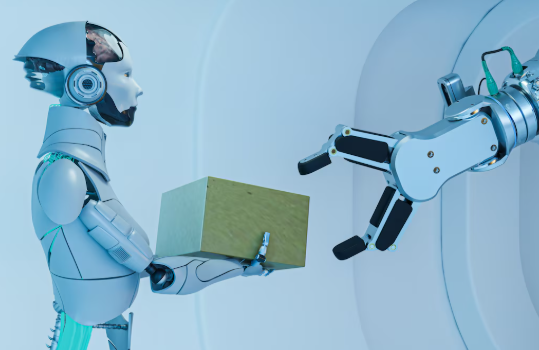Gartner says that hyperautomation is one of the top ten ways that businesses will use technology to improve their businesses in 2022. Organizations use advanced technologies like artificial intelligence (AI) and robotic process automation (RPA) to streamline their processes through hyperautomation.
Gartner also said that hyperautomation had become a necessity instead of an option. You can read all about hyperautomation in this article.
How Does Hyperautomation Work?
Automation in technology eliminates human intervention in one specific task. Hyperautomation builds on this idea and automates most processes, including automation itself. Companies will no longer have to search for automatable processes and implement automation. AI, ML, and RPA technologies can help organizations automate their business processes without human intervention.
Hyperautomation software uses artificial intelligence (AI) to collect and analyze data about the organizational structure and processes. Then, it improves business workflows, processes, and tasks and figures out which ones can be automated. Data collection includes many advanced technologies, including Optical Character Recognition (OCR) and Natural Language Processing (NLP). These help expand the type of information the software can collect.
After identifying the automatable processes, Business Process Automation (BPA) or Robotic Process Automation (RPA) automates it.
Hyperautomation: Key elements
The primary elements of hyperautomation are:
- Artificial Intelligence (AI): AI differentiates hyperautomation technology from other kinds of automation. It can entirely automate the organization. This is the result of several hyperautomation tools like OCR and NLP used by it. AI gathers data from several sources, including voice and documents.
- Event-Driven-Software: This software manages the workflows using events or changes of state. For example, if a process has several tasks in a sequence, the completion of one job can be an event used to trigger the next. RPAs and BPAs are examples of event-driven software architecture. RPAs automate a single structured task, but BPA can automate various workflows and requires no code.
- Conversational Process Automation: We can connect chatbots with RPAs and automate specific tasks by using the user response as the trigger. This way, we won’t need humans to solve most problems.
Benefits of hyperautomation
The benefits of hyperautomation include:
- Workforce Empowerment: Elimination of repetitive mundane tasks will free the workforce to focus on core tasks important to the business.
- ROI: Analytics provided by hyperautomation technology can help identify critical problems in companies. Solving them will improve the organization’s ROI.
- Agility: Hyperautomation makes the business agile using AI as it can quickly spot organizational changes and include them in the automated workflow.
- Upskilling: With more time for employees, we can upskill them and fill gaps in our businesses.
- Integrations: Hyperautomation supports integration and makes it seamless.
- Efficiency: Hyperautomation technology makes processes efficient, improving the productivity and revenue of the business.
- Accuracy: Humans make errors. Hyperautomation makes functions error free by reducing human intervention throughout the organization.
Challenges of hyperautomation
Hyperautomation streamlines business processes and eliminates mundane tasks with automation. It has several benefits. However, like all new approaches, hyperautomation also has challenges. These problems create a barrier for industries to realize their true potential.
The primary challenges for hyperautomation technology are:
- Lack of Knowledge: As an emerging technology, documentation regarding hyperautomation is limited and challenging to acquire. As a result, industries fear integrating hyperautomation technology into their businesses.
- Excessive Availablity of Automation Software: There are lots of software for automating business processes. Choosing an appropriate one to support business processes is challenging for enterprises.
Other challenges include:
- Understanding if hyperautomation has succeeded in improving business productivity can take time and effort. It would help if we use specific KPIs based on our goals to measure success.
- It is also challenging to stick to the project timeline of hyperautomation. We must deeply understand our organizational structure and business processes to create a feasible timeline.
- It may be challenging to calculate the ROI of hyperautomation. We must thoroughly dig into the processes and methods before figuring out returns up-front.
Use cases
Hyperautomation in healthcare
Through hyperautomation, the healthcare industry can deliver better experiences to patients, increase their revenue, and improve their data collection. We can automate several business procedures, including billing cycles and patient support. Hyperautomation can also manage compliance, drug procurement, and staff scheduling.
Supply chain
Hyperautomation can help solve problems caused by the pandemic, such as a lack of workers that slows down delivery and people not getting products on time. Using RPA, we can automate repeated processes, including procurement, billing, tracking orders, pricing, and maintenance. Such practices will improve the efficiency of the supply chain and increase ROI.
Banking and finance
The banking and finance sectors always need to ensure high-quality customer service. Hyperautomation can give customers more precise and complete information, helping them make better decisions. Moreover, hyperautomation makes the banking service available 24/7, increasing customer satisfaction. The banking and finance sector can also use hyperautomation to be more efficiently compliant.
Retail
Hyperautomation has become necessary in retail as more people have begun placing orders online. In addition, companies can use hyperautomation to simplify ad placement and targeted email marketing by automating them.
Retailers can use hyperautomation to improve and automate backend processes, including billing, supplier management, and transportation. This practice will reduce costs and improve ROI. Moreover, we can use hyperautomation to analyze and predict market conditions in the retail industry.
Conclusion
Hyperautomation is the process of using multiple automation tools. In addition, it automates discovering the business processes suitable for automation. This method keeps people from having to do boring tasks, so they can focus on more important business tasks. We can also use the free time to upskill the workforce. Hyperautomation technology uses AI to collect and analyze data to understand and improve business processes and identify if we can automate them. It includes OCR and NLP technologies to accept data from vast sources. Finally, it uses event-driven software to automate business processes.
FAQs
- How are hyperautomation and intelligent process automation different?
- Hyperautomation uses advanced technologies to take automation to the next level. It eliminates human intervention from the process of automation itself. For this, it uses several tools, including Robotic Process Automation, AI, Machine Learning, and process mining. These tools help identify automatable processes and automate them without our assistance. Therefore, intelligent automation is only a part of hyperautomation. Other types of automation are RPA, NLP, Digital process automation, etc.
- How do I successfully implement hyperautomation in my business?
- To successfully implement hyperautomation, you need to understand business goals. You must ask questions to know if you want to improve ROI, reduce errors, etc. In addition, you must know the extent of hyperautomation needed. After choosing a goal, the next step is understanding more about the tools. Lots of hyperautomation tools exist in the market. Understanding the right kind would be challenging. Understand whether you need a low-code tool or something that requires more expertise.
- What challenges could I encounter with hyperautomation, and how do Isolve them?
- While implementing hyperautomation, you might encounter several challenges. If you are inexperienced, Hyperautomatin services may help you solve these.
- Understanding your processes: You can solve this challenge using process mining to understand gaps and shortcomings.
- Unstructured/Structured Data: No all data is similar. You need to differentiate between structured and unstructured data and find ways to feed them to AI.
- Tracking: Automation may fail to be successful. To know the impact, predict your expectations as efficiencies and ROIs.
- Appropriate Platform: Choosing from the different hyperautomation platforms can be challenging. Industries need to research thoroughly before selecting one.
- While implementing hyperautomation, you might encounter several challenges. If you are inexperienced, Hyperautomatin services may help you solve these.



